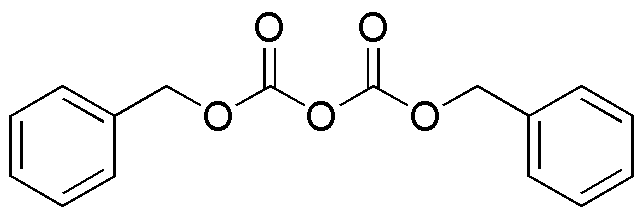Dibenzyl dicarbonate is widely utilized in research focused on:
- Protective Group in Organic Synthesis: This compound serves as an effective protecting group for amines and alcohols during chemical reactions, allowing for selective transformations without unwanted side reactions.
- Pharmaceutical Development: It is used in the synthesis of various pharmaceutical intermediates, enhancing the efficiency of drug development processes by simplifying complex reaction pathways.
- Polymer Chemistry: Dibenzyl dicarbonate acts as a reagent in the production of polycarbonate materials, which are valued for their strength and transparency in applications like eyewear and automotive parts.
- Bioconjugation: The compound is employed in bioconjugation techniques, facilitating the attachment of biomolecules to surfaces or other molecules, crucial for developing targeted drug delivery systems.
- Research in Material Science: It is used in the formulation of advanced materials, contributing to the creation of coatings and adhesives with improved durability and performance characteristics.
General Information
Properties
Safety and Regulations
Applications
Dibenzyl dicarbonate is widely utilized in research focused on:
- Protective Group in Organic Synthesis: This compound serves as an effective protecting group for amines and alcohols during chemical reactions, allowing for selective transformations without unwanted side reactions.
- Pharmaceutical Development: It is used in the synthesis of various pharmaceutical intermediates, enhancing the efficiency of drug development processes by simplifying complex reaction pathways.
- Polymer Chemistry: Dibenzyl dicarbonate acts as a reagent in the production of polycarbonate materials, which are valued for their strength and transparency in applications like eyewear and automotive parts.
- Bioconjugation: The compound is employed in bioconjugation techniques, facilitating the attachment of biomolecules to surfaces or other molecules, crucial for developing targeted drug delivery systems.
- Research in Material Science: It is used in the formulation of advanced materials, contributing to the creation of coatings and adhesives with improved durability and performance characteristics.
Documents
Safety Data Sheets (SDS)
The SDS provides comprehensive safety information on handling, storage, and disposal of the product.
Product Specification (PS)
The PS provides a comprehensive breakdown of the product’s properties, including chemical composition, physical state, purity, and storage requirements. It also details acceptable quality ranges and the product's intended applications.
Certificates of Analysis (COA)
Search for Certificates of Analysis (COA) by entering the products Lot Number. Lot and Batch Numbers can be found on a product’s label following the words ‘Lot’ or ‘Batch’.
Numéro de catalogue
Numéro de lot/série
Certificates Of Origin (COO)
This COO confirms the country where the product was manufactured, and also details the materials and components used in it and whether it is derived from natural, synthetic, or other specific sources. This certificate may be required for customs, trade, and regulatory compliance.
Numéro de catalogue
Numéro de lot/série
Safety Data Sheets (SDS)
The SDS provides comprehensive safety information on handling, storage, and disposal of the product.
DownloadProduct Specification (PS)
The PS provides a comprehensive breakdown of the product’s properties, including chemical composition, physical state, purity, and storage requirements. It also details acceptable quality ranges and the product's intended applications.
DownloadCertificates of Analysis (COA)
Search for Certificates of Analysis (COA) by entering the products Lot Number. Lot and Batch Numbers can be found on a product’s label following the words ‘Lot’ or ‘Batch’.
Numéro de catalogue
Numéro de lot/série
Certificates Of Origin (COO)
This COO confirms the country where the product was manufactured, and also details the materials and components used in it and whether it is derived from natural, synthetic, or other specific sources. This certificate may be required for customs, trade, and regulatory compliance.

